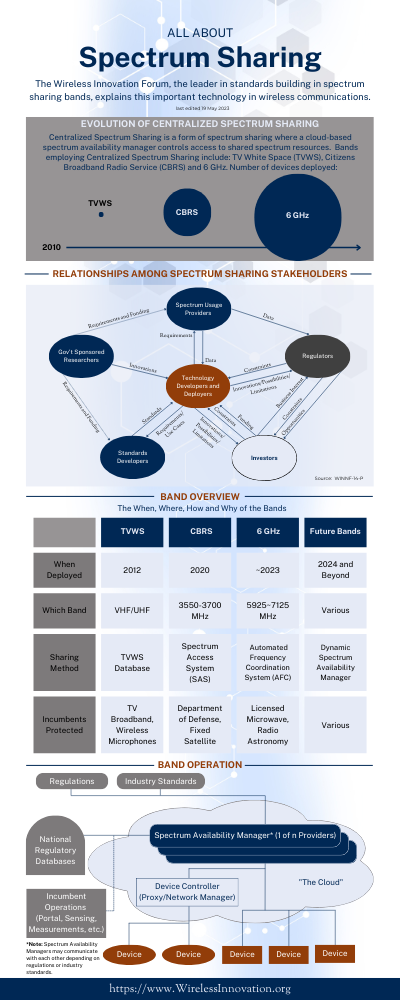- Home
- Knowledge Center
- Reports, Recommendations and Specifications
- Information Documents
- All About Spectrum Sharing Infographic
- Free Webinars
- Tech Talks
- Setting the Standard Video Blog
- Beyond the Radio Dial Video Blog
- Conference Proceedings
- Workshop Proceedings
- Springer Journals
- Market Studies
- What is the SCA?
- Issue Submissions
- Reference Implementations
- What is SDR?
- What are CR and DSA?
- About Us
- Events
- News
- Projects & Committees
- Members
- Join the Forum
Wireless Innovation Forum Top Ten Most Wanted InnovationsInnovation #7: Low Cost Wide Spectral Range RF Front-End (Multi-decade; Contiguous) (Tx,Rx)7.1 Executive SummarySmall, low cost transmitter and receiver front-ends are critical to enable viable wireless solutions in spectrum that is being opened by regulatory bodies to improve spectrum utilization and meet the broadband needs of their citizens. Generally, receiver front-ends are available that continuously operate from 100MHz (or below) to 6GHz today. Front-end technology that allows for either very high blocking dynamic range and / or pre-filtering is still lacking. The definition of High Dynamic Range is vaguely defined and varies. Example: Subscriber equipment may be termed as high dynamic range when 95-100dB blocking dynamic range is exceeded; Base station / infrastructure equipment may be termed HDR when >110dB is met or exceeded. At present, most transceivers continue to utilize a “Velcro” approach towards hardware design. Velcro designs utilize added components external to the core chip set such as duplexers, additional PA devices, switches, and other components to add additional bands of interest to a transceiver or to fulfill circuitry that does not currently offer cost effective incorporation into present-day chip sets or produce required performance even if it could be integrated into the chip set. Present-day transceivers that offer high performance across multiple bands continue to utilize numerous duplexers, selectable filters, and multiple Low Noise Amplifiers (LNA) sections; all external to the core chip set. As the upper limit continues to push towards 40GHz, or higher, another approach is required. Considering 3GPP bands now reach down to 400MHz, the RF performance requirement will soon extend to 2 decades and beyond. It is desirable to make available front-ends that cover extended frequency range; easily two-plus decade RF Front Ends; contiguous, while retaining necessary performance criteria such as tunable selectivity, blocking dynamic range, IM performance, noise figure, and phase noise floor. Out of Band Emissions, frequency stability and tolerance, and low phase noise are some of the critical criteria of the transmitter section of the desired wide band or wide tuning range RF front-end. In cellular chipsets, the method to achieve wide spectral range tune-ability has turned to having a multitude of receiver chains (and associated filtering) for the many bands of interest. A focused review of how to apply these approaches to continuously operable systems would be a new path forward. 7.2 Application This innovation supports applications that require an RF front-end, capable of transmitting and receiving over a very wide spectral range. For example, front-end implementations capable of operating within TV Whitespace allocations in a continuously-tuned fashion. Designs must include operation over all TV channels, regardless of world region, while retaining the ability to operate in the presence of strong adjacent and alternate TV transmitters. An additional example would be a continuously-tuned front-end that could take advantage of licensed broadband / LTE services as well as unlicensed, lightly-licensed, and leased spectrum. Such a device might conceivably operate from below 400MHz through 40GHz or higher. An upper limit of 6GHz is easily justified today. 7.3 QualifiersThe innovation includes transmit and receive subsystems, should be low cost and small in physical size, with acceptable power consumption, multi-octave operation, and high linearity on receive and transmit. In addition to “extreme tune-ability”, the need for a multitude of transceivers to support Multiple-Input-Multiple-Output (MIMO) systems across continuous, tunable spectrum will further increase the complexity of these systems. Therefore, this topic remains critical and has expanded in scope since first considered. 7.4 DescriptionRegulatory bodies around the world are looking for opportunities to improve spectrum utilization and provide more broadband service for their constituencies. Often, the spectrum “white-spaces” that are becoming available are not contiguous and are located in harsh RF environments. Noted above is TV whitespace where there could be one or more unoccupied 6MHz channels across the broadcast television allocation. Guard band spectrum found between service allocations is also applicable[1]. A viable product solution using this spectrum needs to be producible at low cost, operate over this broad frequency range because the unoccupied channels vary by geographical area, and have a receiver that can tolerate a high power TV broadcast signal on adjacent or alternate channels. Design of receivers involve high linearity front ends coupled with tunable pre-selection or its equivalence. For reference information, see section 6 on TVWS in “Public Safety Interference Environment – Raising Receiver Performance Requirements” http://groups.winnforum.org/p/cm/ld/fid=88, December 3, 2009, Session 3.2) Another example is that of opportunistic and as-needed broadband spectrum access. Devices are generally designed to operate on several pre-determined bands. These bands are generally described within 3rd Generation Partnership Project (3GPP) documents and are standardized. In general, devices are regionalized; they are populated to operate on regional bands with sufficient overlap so that some world-wide access is guaranteed. Private networks, extensions of public carrier networks, and device to device communications may utilize additional spectrum, such as database driven licensing at 3.5GHz and unlicensed spectrum at 5GHz, to accomplish one or more of these goals. Additional spectrum will also likely be identified that can be used for similar needs or to further augment capacity through discontiguous bonding. To that end, front-ends of the future should evolve towards continuous spectrum use ability. Substantial challenges must be overcome to ensure that performance criteria, noted above, are sufficiently met. [1] https://www.fcc.gov/wireless/bureau-divisions/mobility-division/700-mhz-guard-bands |



